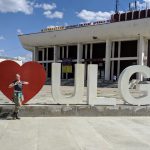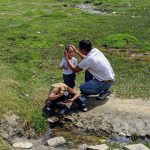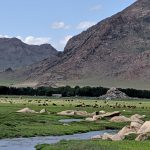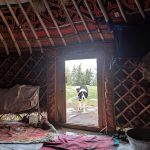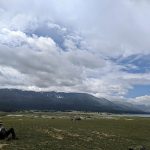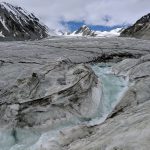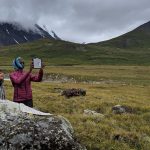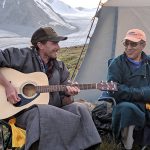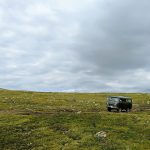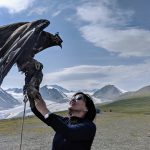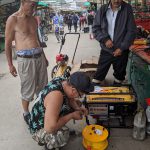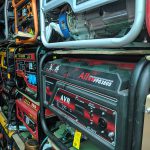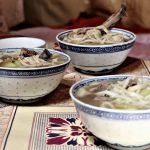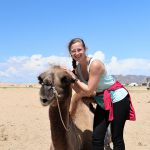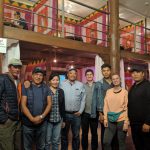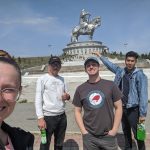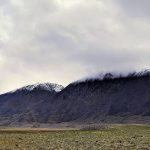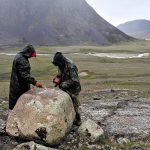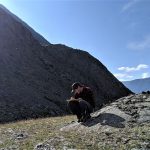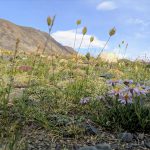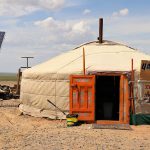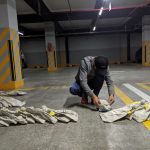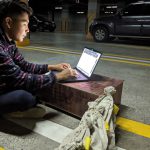By Stephanie Fox, August 20, 2019 –
I should probably explain that headline.
In mid-July, I left my Illinois home and headed to Chicago’s O’Hare International Airport. That’s where I met up with two scientists, a high school teacher and a rising university freshman. Together we boarded a plane to Beijing, China, then Ulaanbaatar, Mongolia, situated between China and Russia.
The team of scientists, headed by climatologist Aaron Putnam, are tracking the retreat of glaciers from the past ice age for clues to reveal climate triggers that human-forced climate change may be pushing much harder now.
Mongolia is where our crew of travelers conducted this incredible climate research, and I’ll be reporting on the work from the field: Fox in the Field.
So, let me introduce everyone because, let’s be honest, they’re the reason I’m here.
This whole expedition started with Aaron Putnam, assistant professor with the University of Maine’s School of Earth and Climate Sciences. A few years back, Aaron drafted a National Science Foundation grant proposal. It explained the research he and the team I’m with will be doing on this trip. NSF gave the proposal good reviews but didn’t fund it on that first round.
That didn’t stop Aaron. Instead, he wrote a proposal to the Comer Family Foundation who gave him enough funding to cover his first Mongolian trip in 2014 with Ph.D. candidate Peter Strand. They helped perfect a time machine for clocking elements in rock that could tell them when the rocks became ice-free. Then Aaron wrote a second proposal to the NSF. Again, it was rejected, not an unusual pattern for NSF funding. The Comer Family Foundation agreed to support another year of research, giving Aaron more data, and then NSF funding for a multi-year research program came through.
Speaking of the Comer Family Foundation, I want to mention an exceptionally important individual – Stephanie Comer. She is a member of the Comer family, carrying on the legacy of her father Gary Comer who started the foundation. Not only does the Comer Family Foundation grant young scientists across the country seed money to launch their research, but it is also responsible for creating the Comer Education Campus on Chicago’s South Side. The campus includes the Gary Comer Youth Center, Gary Comer College Prep, Gary Comer Middle and UTMOSTU. The foundation also has a hand in health care by supporting harm reduction-centered syringe access programs. Stephanie Comer, her son and his friend joined us in Mongolia.
Aaron’s NSF funding covers a high school teacher and a recent high school graduate. I mentioned that the Comer Family Foundation is responsible for Gary Comer College Prep, a Noble Network charter high school located in Chicago’s Greater Grand Crossing neighborhood. Jess Stevens (an environmental science teacher at the high school) has gone on all of these trips with Aaron and Peter since 2016. Each time she brings along one of her students. This year that student is Patricia Joyner. She just graduated from Gary Comer College Prep, she will be studying with Aaron and Peter at the University of Maine starting this fall as a science major and as Aaron’s undergraduate researcher.
When we got to Ulaanbaatar we met the other half of our team. Boldoo Baatar, Baysaa Todmandakh and Bagi Gurkhlaajar are our drivers and guides. Bagi’s long-time friendship with the man who runs the Altai National Parks is actually the reason Aaron and Peter gained permits to collect glacial samples. Baldoo’s wife Otgoo Nyamdaa and Baysaa are our cooks. Tumur Batbold – Boldoo and Otgoo’s son and a student at the Mongolian University of Science and Technology along with his classmate Oraza Seribol – are the Mongolian student participants, counterparts of Patricia.
Everyone except for Oraza gathered in Ulaanbaatar for two days where we picked up supplies from a grocery store whose wide range of items reminded us of a Mongolian version of Costco and a generator. We got the generator from an outdoor market where items are sold cheaper than in stores.
From there, we piled into three cars and made the three-day journey to Ulgii, a smaller city in Western Mongolia. That’s where we picked up Oroza.
Next stop: the Altai Mountains to set up camp and start collecting samples.
Now for the science!
So, here’s where things get interesting. In broad terms, Peter’s Ph.D. research involves constructing past glacial chronologies and climate variability using beryllium-10 surface-exposure dating techniques.
What does that mean?
The supernovas in our galaxy are stars dying in an explosion of light and energy. This explosion breaks apart the highly energetic atomic nucleus (the small dense, region at the center of an atom containing positively charged protons and neutrons that have no charge) and hurls these particles through space at near light speed. They’re called cosmogenic rays or, more commonly, cosmic rays.
Due to an interaction with our sun’s magnetic pull, the cosmic rays hit the Earth’s atmosphere in a shower of mostly protons.
These protons, colliding with the atmosphere, rain down streams of secondary particles that interact with the quartz mineral found in rocks, a recipe of one-part silicon and two-parts oxygen. As the particles interact with the quartz, they break apart the silicon and oxygen and leave behind beryllium-10.
And that’s the only way beryllium-10 can be formed – the time machine in the rock. The longer the rock has been exposed to the atmosphere – free of glacial ice – the higher the concentration of beryllium-10, a way to clock the time since the glaciers moved on. That’s what makes what Aaron and Peter are working on so precise. But I’m getting ahead of myself.
Despite glaciers appearing to be a solid chunk of ice and snow, they are constantly flowing downward as they grow during ice ages. This means that anything that gets caught in a glacier, gets churned in this conveyor belt until the glaciers begins to recede and tosses aside its debris. And this can happen to rocks, tossed from the glaciers like so many pebbles. While trapped, the glacier not only smooths the rock, but also resets it, decaying all the beryllium-10 back into silicon and oxygen.
Now there are these rocks piling up at the edge of the glacier, with these very distinct characteristics. We call that a moraine. And they once again have access to the secondary particles streaming down from the interaction between cosmic rays and Earth’s atmosphere.
So, beryllium-10 starts forming.
In other words, if a sample is taken that reveals the rock’s quartz to contain 7.6 beryllium-10 atoms, we know that the rock has been exposed to protons for 2 years. The glacier likely receded from the rock only two years before.
Of course, this is just an example, and testing for beryllium-10 is no trivial task, but that gives you an idea of how this all works. The moraine rocks Peter and Aaron are clocking started collecting beryllium-10 when the ice receded thousands of years ago.
So, the next couple of weeks we will be hiking into the Altai Mountain, taking moraine samples and returning them to the United States, where Aaron and Peter will use the information gathered to determine the retreat of glaciers.
Peter will use the data collected in Mongolia, as well as at his other field site in Eastern Tibet to compare the retreat of the glaciers around the world. This will not only reveal how far the glaciers have receded, but also give us an idea of how quickly.
And that’s important. The speed of receding glaciers in the past compared to the present gives us clues about how hard we are pushing climate change with human fossil fuel emissions.
A Journal of Our Research Trip
7/15/19
I met Aaron, Peter, Jess and Patricia at O’Hare International Airport, where we made the 24-hour journey from Chicago to Beijing, China, to Ulaanbaatar, Mongolia. Preparation for the trip came in the form of a laundry list of items to acquire (such as a headlamp, sleeping mat, nail clippers and more), a practice hike at Swallow Cliff Woods near North Palos Township, and about a dozen vaccines (Bubonic Plague and rabies are both highly prevalent in Mongolia).
Because of the time change we arrive in Mongolia two days later.
7/17/19
Our Mongolian guides greeted us at Ulaanbaatar Airport. Aaron, Peter and Jess walked into the open arms of Boldoo Baatar, Bagi Gurkhlaajar and Tumur Batold. When Aaron met the Mongols on his first trip to Mongolia in 2014, they were hired helpto drive his crew to their field site, prepare food and keep them safe. Three trips and 5 years later, they’ve become family.
Once picked up, we made the 45-minute drive to our hotel. When we got there, I was handed what looked to be a military dog tag. Confused, I asked Boldoo what to do with it, to which he responded with a single word: “Key.”
When I got to my room, I passed out immediately. After traveling for so many hours—always in sunlight—I was ready to crash.
We arrived at our hotel around 1:00 a.m. and I was up again around 7 a.m. Before our scheduled 9 a.m. breakfast I showered and organized my things.
Breakfast was served in a small coffee shop attached to our hotel. A waiter brought everyone the same thing: toast, sliced tomatoes, eggs, ham and a generous squirt of mustard. I looked down at my plate and quietly pulled out one of my MREs – Meals Ready to Eat to maintain my vegan diet.
When I discovered I would be traveling to Mongolia a few months prior to my departure I had images in my head of vegetable bao and fried tofu—Asian cuisine I’d grown used to feasting on in the States. I imagined eating like a vegetable queen.
But Mongolia is one of the most meat-heavy places on earth. Due to the nomadic history of the country and the firm ground that prevents gardening, meat and milk are the two most common foods. It’s worked for the Mongols for centuries but wasn’t going to work for someone like me—a vegan for 4 years.
That’s why I packed myself two months’ worth of military-style food. Though I was only in Mongolia for one month, Aaron and I were concerned about me either not having enough to eat and getting sick, or my bag getting lost in transit and me being foodless. Because of that, I divided my hiking gear and food into two different bags. Luckily, all of my bags made it, giving me a surplus of food.
After breakfast, Boldoo and Tumur picked up Aaron, Peter and me. We headed to immigration where Peter and I waited to receive visas to stay in the country for more than 30 days. Tumur snagged a number from a machine, like a grocery store deli, and we waited to be called.
When we returned to the hotel, everyone was ready for lunch.
We walked back to the hotel after lunch and split apart again, each heading to our rooms. Desperate to beat my jetlag by not sleeping during the day, I read Ghenghis Khan and the Making of the Modern World. Only, reading brought me to the brink of sleep, so I decided to walk up and down the hotel stairs, getting my blood pumping, and hoping that the activity would keep me awake until dinner.
Our next meal turned out to be well worth the wait. Our guides picked us up and drove us to an Afghan restaurant called Hazara where our table was piled high with naan, samosa, butter chicken and more. I filled my plate high with rice, dal and naan, eating heartily and thinking about how any spoonful could be my last filled with something other than an MRE for weeks.
7/18/19
Jet lag.
I wake up at 1:00 a.m., 3:00 a.m., and 4:00 a.m.
I couldn’t get back to sleep, so I read through groggy eyes.
Breakfast was set for 8:00 a.m. – back downstairs to the little coffee shop with my MRE oatmeal in hand.
On the menu I saw vegetable juice and excitedly made the order, only to be handed a tomato milkshake. I smiled at my server then pushed the dairy-made beverage to the other side of the table, offering it to Aaron when he entered.
While I spooned up oatmeal, the rest of the crew ate salad covered in orange marmalade and chicken sandwiches.
After breakfast, Boldoo picked up Aaron, Peter and me to grab some miscellaneous items from the Ulaanbaatar black market. Jess and Patricia went with Tumur and his mother Otgoo Nyamdaa. She became the assistant chef on our trip.
We arrived in a massive lot that looked almost like a flea market except that all of the “shops” were built out of storage units stacked on top of each other. We followed Boldoo as he navigated the winding path, leading us to a storage unit piled high with generators. We buy the generator from
Boldooa man wearing a shirt decorated with marijuana leaves, and sunglasses despite the cloudy sky overhead and head off to buying other supplies.
After purchasing a food tent and 12 chairs, we returned to pick up the generator and watched same man who had helped us before snip off the plug and start gnawing on the protective covering to reveal the wire inside. He then fed the wires through a new plug, allowing the generator to be plugged into American outlets.
As the men who’d sold us our goods helped load Boldoo’s pickup truck, we received a call from Jess asking how she should pay for groceries. That’s when Aaron and Peter realized neither of them had given her money. So, we piled into the truck and headed to the grocery store. There, we picked up pickles, meat, ramen and a lot of Snickers bars. These bars functioned as snacks on the go, second breakfasts and desserts.
Once everything was sorted out, we headed to a Chinese restaurant where we met Baysaa, our primary chef on the trip. Everyone ate rice and lamb ribs and Jasmin tea (only rice and tea for me!). While I nibbled on bread, Tumur attempted to teach Patricia Mongolian words, while Patricia taught Tumur Spanish.
7/19/19-7/22/19
On a gray and stormy morning, we piled into three off-road vehicles and headed to Ulgii, a city in western Mongolia that would end up being our final stop in civilization before heading into the Altais.
The drive covered three nauseating days of car sickness as we navigated sharply winding roads and steep dips. Between breaks at gers for lunch where bone stew and milk tea were served and an impromptu stop to watch about 100 children under the age of 7 race horses, we sped across the rugged terrain. The feeling of the drive oscillated between Disney World’s Raging Mountain and the swinging Viking ships found at every amusement park under the sun. There were times
Multiple stops to deal with one of the car’s faulty fuel pumps made the stomach-churning drive even worse. Each time this happened, we squeezed four people into the back seat of a pickup truck and left the broken car behind to be “fixed”—or at least functional enough to carry on. In order to fit, we threw caution to the wind, and with it, our use of seat belts. Needless to say, whenever we hit a bump our heads collided with the ceiling.
Toilet facilities meant stopping for a squat behind boulders or tall tufts of grass.
On the second evening of our drive we slept under a starlit sky in our four-season tents on a night with weather so perfect it wrapped us in a blanket of warmth and lulled us to sleep.
Our sleeping bags felt like home compared to the middle school dorms our Mongolian guides had found for us to stay in the night before. The school where we had been invited to spend the night had suspicious holes in the walls of unknown origins, wallpaper on the floors and bedframes piled with uneven cardboard under the 2-inch-thick mattresses.
As we walked down the creaking, uneven hall to our rooms, Jess said she was getting “serious Resident Evil vibes.”
All of that melted into a dream as we got back on the road and I watched the landscape shift from city, to desert, to valley, to mountain.
We spent two days in Ulgii, meeting the last official member of the team, Oraza Serikbol. Like Tumur, he is a student at the Mongolian University of Science and Technology (MUST). By inviting MUST students to join the expedition, Aaron has not only found advocated to help obtain permission to sample boulder’s in Mongolia, but he has also provided an incredible opportunity for young Mongolians to see a part of their country they otherwise may never have ventured to.
7/23/19-7/27/19
We left Ulgii and made our way to the first campsite.
After a long day’s drive and setting up camp, we ate dinner—curtesy of Baysaa and Otgoo—and went to sleep.
In the morning the group ate a savory breakfast of sausages, pickled vegetables and bread with a cheese so glossy everyone double checked to ensure that the plastic covering had been removed, then left behind our guides and approached the base of the mountain. Dark clouds overhead combined with the brisk morning air had convinced me to put on my base layer, sweater, winter coat and raincoat, which made mobility awkward. Our packs were weighed down with water bottles, rain clothes, notebooks and about a pound per person of rice for lunch.
The tools meant for sample collection were divided up among the group. We learned quickly that the power drill, with its weight, hindered a balanced climb and, with its odd shape, made for an impossible fit inside a hiking pack.
What looked to be a short climb from the bottom of the mountain turned into an hour of heaving loudly and heavy steps. Often, I pushed ahead of the group to snap pictures of their climb only to bend over and grab my cramping side before having time to get out my camera.
Between a gasping breath, I turned to Tumur and joked, “So, you do this all the time, right? Just your morning workout?”
“Yep,” he said, before raising his eyebrows and pushing his lips together to make a straight line. The line shifted into a smile as he let out his own heavy breath. “This is hard.”
Boldoo likes to call Tumur “city boy” because he was raised in Ulaanbaatar. While the city’s diameter is made up of sky-scraping mountains, climbing them for fun isn’t a typical pastime. Tumur only gets this kind of exercise when Aaron and Peter travel to Mongolia.
When we finally made it to a good moraine for sample collections, the clouds had split, and the sun glistened off the tips of the green and yellow grass. We unhooked our packs and let them crash to the ground. Mine made a satisfying clunk as a water bottle carabined to the side made contact with bedrock, sending the water sloshing back and forth.
Tumur and Oraza hopped from rock to rock, bending down to pick up pebbles or to get a better look at scratches made in large pieces of stone. Jess and Patricia—the last two to make it up the mountain—sat down to catch their breath. Aaron and Peter walked through the low grass, setting their hands on boulders and letting their palms run across the tops.
They were feeling for the smooth polish that identifies boulders as having lived inside a now-receded glacier.
Eventually, Peter found one that seemed sufficient and called the student scientists over to feel the boulder’s surface for themselves.
Then, Aaron instructed everyone to get out their field books and start taking notes.
Before any samples could be collected, the crew drew the boulder and wrote out a list of characteristics, such as its size and shape.
An ideal sample fits several criteria:
- It has a smooth polish that characterizes it as having been processed within a glacier
- It’s rounded, demonstrating that significant pieces haven’t been chipped off
- The top surface has not been eroded by outside forces, such as bird excrement
- It sits at the top of a hill and its bottom is fully or mostly visible, showing that it had to have been set into place by the force of a glacier
- It’s large, so it could not have been rolled over easily, changing the placement of where secondary particles from streams of cosmic rays strike the surface and generate beryllium-10.
Not every boulder meets all these standards, but those are the general tells as to whether a boulder would make a good sample or not.
While jotting down the boulder’s description, Patricia asked questions: “Would you consider this a large- or medium-sized boulder?” and “What’s the scientific name for its shape?”
Her questions are welcome and encouraged.
A week earlier, as we sat in an Ulaanbaatar Korean-inspired restaurant, Aaron had passed on some advice to Patricia and Tumur given to him by glaciologist George Denton, his Ph.D. advisor and Peter’s master’s advisor at the University of Maine.
“Science is the asking of good questions,” Aaron relayed. “So, ask lots of questions.”
During the first field day, that mostly meant asking, “Am I doing this right?” and “Can you help me?”
That was particularly true when it came to Tumur, Patricia and Oraza learning how to take samples.
Tumur picked up the drill and began making small dents in the boulder. Aaron instructed him to make the dents in a straight line to prevent the risk of getting equipment stuck. With four or five dents formed, Tumur placed the drill back into each hole and pushed firmly against it to deepen the dents into finger-length tunnels.
Then, Peter showed Oraza how to insert shims and wedges into the holes. By placing wedges between two shims and hitting them with a hammer, the rock is forced to split, releasing the desired sample. But there’s a trick to getting out the perfect sample. Once the shims and wedges were in place, Oraza was instructed to start at one end and hit the wedge until the sound echoing off the hammer grew to a high-pitched ding. Then he moved to the next wedge and did the same, constantly moving down the line until reaching the last wedge, then starting over.
Ultimately, we heard a crack.
“Yes! Beautiful,” Aaron said.
The sample was exactly what Aaron and Peter were hoping for. It was long and thin, and full of quartz, the mineral needed to time the retreat of the last glaciers as the boulders broke free of the ice.
Before packaging up the sample, Peter called Patricia over to the boulder and handed her a brick-sized GPS, which is used to identify the exact coordinates of the sample. Gathering that information takes about 5 minutes as the GPS beeps to assure us it is doing its job.
Peter then took out his iPad and opened an application that maps the skyline. This is important because when the information is entered in an algorithm it can tell Aaron and Peter how the secondary cosmic rays hit the surface of the boulder.
Finally, photographs were taken of the boulder, the samples were placed into a canvas bag, and the crew was ready to move onto the next boulder.
We had to walk for quite some time before coming across a boulder that met enough of the correct criteria to make a good sample.
At dinner the night before, Aaron and Peter had said they weren’t sure how many samples they’d get the next day.
“We just don’t know how many boulders we’ll be able to sample from until we’re there,” Peter had said.
As I sipped sugarless black tea and stared up at the mountain we were scheduled to climb the following day, I’d thought, “How can that be? There are so many rocks up there.”
Trudging through wildflowers and stepping over jagged rocks, I watched the team run their hands over car-sized boulders and realized what it takes to find a good sample.
As we moved from one rock to the next, Aaron and Peter sat back while the student scientists taught each other the skills they’d learned. Acting as middle-man Tumur translated between Patricia who only speaks English and Oraza who only speaks Mongolian and Kazakh.
After a quick lunch and an excursion over a waterfall, the weather shifted, and we got caught in a rain shower. We rushed to slip into rain pants and cover our packs just as the storm picked up and the water turned cold.
But even the rain couldn’t stop the team. As our fingers numbed and our bodies shivered, we hit a stroke of good luck in the form of three boulders side-by-side, perfectly situated for sample gathering.
In a silent agreement, Tumur, Patricia and Oraza picked up equipment and began to divide and conquer. Tumur drilled, Oraza hammered, Patricia obtained the locations using a GPS. They moved like a well-oiled machine.
“We have enough for the trip,” said Aaron. “But I hate leaving any trace behind.”
The team moved on to their final boulder of the day.
This boulder was huge, round and smooth.
As we approached it, Peter said, “Tumur, what do you think?”
Tumur set his hand on the rock and shrugged.
“Seems okay,” he said.
“And Patricia, how does this compare to some of the other rocks we’ve been using?” Peter asked causing Patricia to set her pencil down and look hard at the boulder.
“It’s buried in the ground,” she answered with a high-pitched tilt to the end of the statement making it almost sound like a question.
Peter agreed and explained that though the boulder was buried, it met other criteria that made it a good boulder to take samples from.
So, as the rain poured and the wind pressed our clothes hard against our bodies, Tumur, Patricia and Oraza collected the last sample on the first day of the field season.
Just as the boulder began to split, the weather cleared.
The collected samples sat at the bottom of our packs, along with the extraction equipment making our already-heavy packs even heavier, but none of us minded because for the first time since morning the sun was shining into the valley.
The next few days carried on in a similar fashion, except for one major difference. Patricia had begun to develop stomach pains. At first, it didn’t seem like something to worry about. But as the days went on, her pain increased.
7/28/19
We had a plan. It was a good plan. It was a well thought through plan.
But the day had something else in mind.
We woke up and began packing up the camp to move to the next site. Once on the road, the journey should have taken no more than five hours.
Ideally, we would head to our new spot and the next day Aaron and Boldoo would head back to Ulgii to pick up Stephanie Comer, her son Luca Craigie, 16, and his friend Enzo Filippetto, 16. If Patricia was still in pain then, she could join Aaron and Boldoo and visit an Ulgii doctor.
But as we drove along and Patricia’s cries of pain grew, we hit a checkpoint that changed our plans completely.
Our three cars came to a river that should have been low enough to cross—but it wasn’t. It sped past in a wave of bubbles and kicked up stones. Clearly, the rain we had been having up in the mountains had caused the river to flood, making it appear impossible to cross.
But “impossible” isn’t in the Mongols’ vocabulary.
Boldoo, Baysaa and Bagi lined their cars up, preparing to tie them together, front to back. Boldoo’s truck being the biggest was set to role into the river first, followed by the other cars tethered using orange and purple towing rope.
But in the distance, Aaron—who had been pacing uneasily for some time—noticed Patricia hunched in a ball due to stomach cramps. Jess stood over her with concern.
I watched as Aaron walked over to them, helped Patricia up and moved them closer to the larger group.
After a hushed conversation between Aaron and Boldoo, it was decided that instead of crossing the river we would all return to Ulgii to get Patricia to a hospital. So, we piled back into the cars and our guides entered “Ulgii” into their GPS’.
Again–we had a plan. It was a well thought through plan.
But the day had something else in mind.
Once back on the road, the drive should have taken no more than six hours.
Our coordinates were set, and the Mongols were doing what they do best—pretending to be race car drivers, flying up hills and splashing through streams.
But as we approached a spot where there should have been a bridge, a Kazakh man appeared almost out of thin air on his motorcycle. We never caught his name, so he will forever go down in history as “Motorcycle Man.”
Motorcycle Man informed our drivers that the road the GPS was leading us toward was only available in the wintertime when everything was frozen. But he assured us there was another way to get to Ulgii; he offered to show us.
This led to our back tracking, then taking a turn into a large grassy landscape that quickly revealed itself to be boggy due to the recent influx of rain in the area. Almost instantly, Bagi’s car got stuck in the mud. Boldoo attached the same rope he had originally planned to use to cross the river onto the back of his truck and the front of Bagi’s car. The car was freed instantly.
But almost as quickly, Boldoo’s truck got stuck. The tires were completely buried all the way up to the underside. I learned the term for this is misshap – “beached it.”
Everyone hopped out of the cars they were in to help out. Immediately, we were hit with the heat of the sun and thousands of swarming mosquitos. Because we had all assumed the trip would be a simple one that morning, our sunscreen and bug spray was buried and initially unreachable.
As we unloaded everything from the back of Boldoo’s truck into a pile, in the hope of making it lighter and therefore easier to move, we found the bug spray and lathered ourselves in it.
Then we got to work.
Tumur and Oraza took shovels and began digging out the tires while the rest of us collected rocks to slide under the tires as a sort of make-shift road.
While this was happening, Motorcycle Man lounged against his bike watching us. Eventually he turned and left. We assumed that would be the last of him, but he ended up returning with two other Kazakhs who jumped in to help us without skipping a beat.
With everyone working together, we were finally able to free the truck after three hours and get it out of the bog.
“What else could possibly go wrong?” I’d asked myself.
That was right around the time we received 4G again and the Mongols’ phones started going into action.. As we made a stop in a small village, so Boldoo could check something on his truck, Otgoo informed me with tears in her eyes that her best friend had passed away that day.
I bounced out of the car and raced to her side to squeeze her in a hug as she sobbed. That was the hardest moment of the day. The truck could be dug out with a bit of elbow grease. But Otgoo’s pain couldn’t be MacGyvered away. And Patricia needed a hospital.
We drove the rest of the way in silence. We arrived in Ulgii around 8:30 p.m. and drove directly to the hospital, an old and somewhat shattered building.
After a prescription was written for Patricia, Jess got her out of there, despite the protest of the hospital workers. The two were overwhelmed and upset. Yet, the trip was technically a success. Within hours of Patricia taking the medicine, she started to feel much better and we knew she would be safe to return to the field in a couple days.
7/29/19-7/30/19
We spent the day in Ulgii eating hotpot and grocery shopping.
Around dinnertime, Stephanie, her son and his friend arrived, and we went out to eat together.
We discussed the disastrous day we’d had before and collectively held our breath hoping we wouldn’t run into anything that unfortunate again.
The next day was spent bumping along back roads to get to the campground we were supposed to already have been set up at 2 days prior.
As we entered the national park we discovered the mud to be wet and soft, which was stressful because of the loud revving sound the engines made as the cars pushed up hill, and because the memory of digging the truck out of the mu for three hours played on repeat in all of our minds.
Eventually we made it to the peak of a large hill, right above where our camp would end up being. There, we discovered a beautiful monument made up of multicolored fabric and piled rocks. Monuments like this are all over Mongolia, often alongside roads for travelers to pass. When approaching a monument, one is supposed to circle it three times clockwise, tossing small pebbles onto its flat surface, or leaving offerings for the spirits such as animal fat or alcohol.
The peak also had something else: a man with a horse and an eagle. He would forever be referred to as “Eagle guy.” For a small fee visitors of the park could take pictures holding the humongous bird. Tumur saw me staring fondly at the majestic creature and asked if I’d like a picture. Of course, I said yes. Then, one by one everyone filed in to get their picture taken with the eagle.
While I admit I was the first in line, as each member of the group walked up to take their picture, a knot started forming in my stomach. I’ve heard the horrors of wildlife tourism and worried I was contributing to the poor treatment of animals. I asked Otgoo as Eagle Man how he handles owning such a large creature. He said he takes the bird out hunting regularly, only bringing the bird out for pictures on warmer days. In a year or so, he will release the eagle to the wild, rather than have it spend its entire life as his pet. This made me feel less guilty. And either way, the bird was so heavy. Clearly it was eating well. I’d like to imagine some of the money we used to get our pictures taken goes toward the care of the eagle—though I’ll never be able to confirm that.
We got back in our cars and drove down the other side of the hill. When the land flattened out a bit, we set up camp and ate bread and coffee, waiting for a delicious dinner prepared by Baysaa and Otgoo.
After dinner, we pulled our chairs out of the dinning tent we’d set up and sat in the open air, watching the birds fly overhead and the mountains glisten as the sun set.
7/31/19
Outside the rain beat down on our tents like little beads bouncing off the tightly held fabric. Despite everything inside of me begging me to stay tucked in the warmth of my sleeping bag, I knew our only having two sampling days in the park meant everyone needed to be awake and alert on time. But as I got dressed and crawled out of my tent, I discovered Jess was the only other person awake. I checked my watch—7 a.m. Had plans been changed in during the guitar playing the night before?
We’d learn later that the Mongols refuse to come out of their tents in a heavy rain. Because Baysaa (our chef) also follows this unspoken rule, and because we needed breakfast in order to head out for the day, it didn’t make sense for anyone to come out into wet weather until the Mongols emerged first.
After about another hour, everyone was awake and eating. Some ate toast; others ate eggs and sausage.
We headed out in small groups. The first to leave were Peter, Oraza, Tumur and I. Next were Aaron and the Comer crew, followed by Jess and Patricia. Our camp sat on the edge of a massive lateral moraine. In order to collect the desired samples we had to climb down the edge through spongy, wet grass and steep rocky hills.
Peter wanted to collect samples from the flat ground where a glacier likely sat thousands of years ago, but as we made it down to flat land he quickly realized there weren’t as many boulders to sample as he and Aaron had hoped. Still, he found some; it simply meant longer walks between samples.
We’d experienced rain on and off throughout the day. The cold seeped through our jackets making us shiver. I walked in circles or huddled in a ball to stay warm as I watched Oraza, Tumur and Patricia chip away at boulders and stick samples in canvas bags.
The rain finally cleared when we decided to head back. At some point earlier on, Luca and Enzo decided to leave the group and attempt to climb a mountain. Stephanie and I split off to find them only to discover they had climbed a third of the way up. We called to them and watched as they slid their way down to lower ground where we met them on our way back.
The science team hung back to take drone images while we walked back to camp. Between the four of us, we were sure we would be able to find our way. But after about two hours of walking up hill and slipping into knee-high wetlands we started to question if we were lost. The walk down hadn’t seemed so long, and all of the moraines started looking the same. With so many hills blocking our view from above and below we had no idea whether we’d passed our camp or if we had more to walk.
We calmed ourselves only to come over a hill and see nothing but an endless sprawl of moraines.
We did miraculously eventually find our camp, exhausted and relieved.
An hour later the rest of the team strolled in—and just in time. Almost as soon as they appeared a film of fog crept over the moraines and into the valley creating an impossible wall of white. Finding camp with clear air had been difficult enough. I can’t imagine what we’d have done had the fog hit a couple hours earlier.
8/1/19
Despite the unfortunate weather of the day before, we woke to a perfectly clear sky. The sun shone down and gleamed off the tips of the glaciers across from our camp.
Aaron and Peter had prepared for us to hike down into the valley over very young moraines (maybe even less than 100 years old) and walk onto an actively melting glacier.
Walking down the moraine was a challenge for everyone. While older moraines are covered in foliage and firmly set in place, these young moraines were more like a sand dune covered in boulders. There was a constant fear of falling or the rocks rolling out from under our feet. On the way down I stepped down and the ground crumbled away from me, causing me to slide a few feet before stopping as my shin slammed into a sturdy boulder. I gritted my teeth and ignored the swollen throbbing, determined to finish my descent quickly.
As usual, Peter and Oraza touched down first, followed by me and the Comer crew. Aaron had originally been keeping stride with Peter until he realized Patricia struggling at the top of a hill and hiked back up to help Tumur and Jess show her the way down.
Once we all got on the ground, Peter led us to the glacier’s edge, and we stepped on. The ground was lumpy and slightly slippery, with rocks and animal bones melting their way through to the surface, We hopped over the most beautifully clear water, admiring the way it snaked it’s way left and right, waterfalling into deep caverns too dark for us to spot the bottom only to reemerge elsewhere down the glacier.
Aaron and Peter wanted to collect samples from rocks as they poked through the glacier ice or sat atop it on puckered ledges that made the glacier look like it was putting the rocks on display to see if any beryllium-10 would be present. Their assumption is that there won’t be, but there’s no way to be certain until they process the samples back home.
The field day was cut short due to our long hike we’d had the day before, so after lunch we packed up our backs and headed back up the moraine. We took a different path up than we did to come down, which initially appeared more stable until I stepped into sand-covered sludge that came up to my calves and caked my feet.
Hiking up a moraine is hard. Hiking up a moraine while carrying a 70-liter hiking pack is harder yet. Hiking up a moraine while carrying a 70-liter hiking pack and having your feet caked in heavy, wet sand is even harder. Still, I knew stopping for breaks would only make the already seemingly endless walk even longer, so I kept moving until my back ached and my feet cramped.
This time, we stayed together on our walk back to camp, arriving just as a light shower moved in. But the rain couldn’t change the fact that we’d had an incredible day, which is wonderful because it was the last field day for the Comer crew, Patricia and Jess. The next day they’d head home.
8/2/19
We hugged a lot as our groups prepared to separate. Packing up camp, we helped each other take down tents and wrap up boxes of food. Patricia, Jess and I discussed our favorite parts of being together on this incredible journey, collectively wishing they could stay until the end. But we knew that wasn’t possible. The day I return to Chicago will find Jess back in the classroom, with only a week before Patricia heads to college.
When everything was packed, we climbed into different cars and made our way back up the mountain to where we’d seen the shrine a few days prior. While some of the group walked around the ribbon laden monument, the man hired to drive the crew going home ran into Eagle Guy and offered him a seat in his car. To all our surprise and delight, Eagle Guy invited us to his family ger, which is where we found ourselves as we exited the border of the national park.
There, we were offered airag, a traditional Mongolian beverage made from fermented horse milk. Our Mongolian guides slurped up bowls of the white-colored wine, while the Westerners smiled and held their bowls in their laps, only bringing them to their lips when Eagle Guy’s family gestured for everyone to take a sip.
Peter and I snuck ours to Bagi who accepted them with a nod and a “thank you.”
We split up shortly after visiting Eagle Guy’s home – half heading in the direction of Ulgii and the rest heading to Khovd Gol (river) where we would set up our next camp.
Some members of the team of 15 had left and we’d dwindled down to only 10. It felt odd not being able to point out beautiful landscapes as we drove to Jess or setting up camp without watching Patricia determinately hammer in the stakes on her own. I hoped that their trip home would go smoothly and feel shorter than it was. But I also knew it would be a few weeks before I’d be able to hear any updates for myself.
Our new camp was isolated. Not only from 4G data, but from people. As we drove up alongside a breathtaking river, passing rock burials and distant trees, we noticed there were no other people in site This wasn’t necessarily unusual considering we’d rarely encountered people at the other field sites, but we did quickly learn there was a reason for this particular spots vacancy: mosquitos. They buzzed around our heads, bit our bottoms as we squatted to relieve ourselves, crawled on our food as we ate lunch and dinner. It was miserable. No amount of smoked yak feces or bug spray could stop them. Still, Aaron and Peter had chosen the spot for a reason and samples needed to be taken.
8/6/19-8/9/19
Our next camp was only about a 2-hour drive away at Khurgan Nuur (lake). Though Peter informed me we could have stayed at our previous camp much longer, the mosquitos had forced us to move on.
Thank goodness.
Our final campground was the most beautiful landscape I’ve ever seen. We staked our tents right next to the lake, whose cool breeze prevented bothersome mosquitos from making an appearance. On the other side of the lake the glaciers towered over, creating a wall of rock, snow and trees. Herders road their horses across the grassy hills, while their goats and sheep ate their way through the greenery. It was perfect.
The first day of sampling surprised us all. As we walked along the flat moraines we found a number of gigantic rocks, but years of harsh weather and rock-climbing goats had eroded the surfaces making them poor samples. Some were collected, of course, but not as many as I think anyone expected as we drove up to the camp.
The next day Bagi drove the science crew to a few hills that Aaron and Peter had sampled from in the past. We spent the day hiking to the top, taking drone images of the landscape and eating bread and canned cow meat (I of course refrained from the meat, though even if I were a carnivore I believe I’d have steered clear as it literally looked like cat food).
That night as we ate huushuur (an empanada-like dish made from folded and stuffed fried dough) and drank Russian beer and vodka, Peter made an enouncement. The next day would be a rest day. Everyone had worked so hard this season, he’d said, that we all deserved a break to enjoy the countryside.
But when we woke up the next morning the sky was too clear, the weather too perfectly calm for Peter to pass up the chance to take good drone images. So, he, Oraza and Tumur left to do work on our day off.
When they returned, they regretted their decision. As the drone returned from its fourth or fifth flight, an eagle attacked it, sending it spinning toward the ground. It’s a good thing the University of Maine has drone insurance, though Peter said he isn’t sure it covers eagle attacks. Time will tell.
8/10/19-8/13/19
I awoke to a rainstorm. Groggily, I forced myself out of my sleeping bag and began packing up my belongings.
The field season was over, and it was time to head back to civilization.
The rain persisted as we took down our tents and loaded up the cars for the last time. After a breakfast of oatmeal, bread and eggs we left behind our stunning campsite.
We drove through storming rivers and across poorly built bridges. At one point we stopped and Oraza an Tumur collected a sample as the rain raged on.
Our first stop was Oraza’s summer ger. After about a four-hour drive we encountered his father herding his animals up a hill on horseback. We followed him to the ger where Oraza’s mother, two sisters, a younger brother and dog greeted us. The dog, a friendly jumper, loved to pounce onto me as I passed, resting his front paws on my arms while maintaining eye contact as if begging me to give him attention.
While I ate way too much bread, everyone else devoured steaming milk tea, chocolate cakes and a traditional Kazakh meal comprised of a lamb head placed atop a pile of flat noodles. I sipped my tea, made from grass, while the rest of the group took out Swiss army knives and tore cooked meat fromf a lamb’s head and shared food from the platter at the center of the table.
We returned to our cars and drove the five hours back to Ulgii where we stayed the night in a hotel with each of our rooms missing at least one essential thing (e.g. toilet paper, soap, working faucets).
Peter and I hoped we to camp in Ulaanbaatar for the next few nights. He and Aaron had previously shared horror stories about some of the hotels the Mongols had found for them on other trips.
But the Mongols are the drivers and in the end they decide where we stay while on the road. Their desire: no more camping. So, we ended up staying in hotels, though to my surprise each one we slept in was cleaner and nicer than the one proceeding it.
Our drive went smoothly, allowing us to arrive in Ulaanbaatar 3 days later in the middle of the afternoon. We were dropped off at one of the city’s best hotels, the Chinggis Khaan Hotel which was by far the nicest place we’d stayed since arriving in Mongolia.
8/14/19-8/15/19
Peter and I met with the Mongols for lunch. We went to a mall where everyone ordered hotpot, while I ate food from a vegan restaurant a short walk away. That’s where we met Uyunga Botbold (Boldoo and Otgoo’s daughter). She works in an office above the floor of the mall where we ate, and she decided to take her lunch break to sit with us and ask us about the field season.
After lunch Peter, Tumur, Oraza and I went to the National Museum of Mongolia where we walked the three floors and learned about the history of Mongolian wardrobes, gers, toys and more.
Later we met up with Boldoo and Otgoo for a mouth-wateringly good dinner at Hazara, the Afghani restaurant we’d eaten at on our first night in Mongolia.
Before arriving in Ulaanbaatar, Peter and I got made reservations at the Chinggis Khaan Hotel for six nights. But as we waited to get picked up the next morning, we received a message from Boldoo explaining that the hotel was kicking us out because they were overbooked.
Shocked, we gathered our belonging and waited for Bagi to pick us up. He drove us to the Batbold’s apartment where Peter, Tumur and Oraza sorted, weighed and packaged each sample. This was done in the apartment building’s parking garage because no other place was available.
When the samples were fully prepared for shipping, we went to an American-style restaurant called The California where we ordered salad, sushi, milk shakes and French fries.
After lunch, we were taken to the Blue Sky Hotel,h was exponentially nicer then than any place we’d stayed. The Blue Sky sits next to the Ulaanbaatar square, has a top floor lounge where cocktails and dinners are served, an all-you-can-eat buffet for breakfast and a gym. I would end up taking advantage of all of these facilities during my time at the hotel.
From there, Tumur escorted Peter, Oraza and me to a throat singing performance where we saw witnessed traditional Mongolian song and dance.
8/16/19-8/18/19
We spend the morning souvenir shopping before meeting up with Oraza and Tumur’s geology professor Uyanga Bold. Bold serves a fundamental role in assisting Aaron and Peter in getting all the paperwork needed to enter the country and ship back the samples. With her help, Peter was able to pass off his four boxes of samples to a man in charge of shipping, before we all went to eat Korean food for lunch.
On the 17th Bagi, Baysaa (plus his golden retriever named Suzie), Tumur and Oraza met us at our hotel to take Peter and me on an adventure. We drove about an hour out of the city on unpaved roads to the largest monument of Genghis Khan in the country. The metal man sits proudly atop a massive horse, dressed ready for battle.
After climbing a winding staircase with halls just big enough for a single-file line of people to move up or down we arrived at the horse’s head and looked out at the Mongolian backdrop. It was beautiful… but claustrophobic. I felt significantly more relaxed when we were on our way out than I did staring off into the distance of the serene landscape.
We’d later have dinner at the Batbold household, where we’d be served homemade buuz (Mongolian-style dumplings) and a generous amount of alcohol.
On our final day in Mongolia, I had asked Otgoo and Boldoo if they would take me to the monastery to interview a lama for a story I’m working on. The experience ended up being life changing.
Over a dozen brightly colored buildings sit within the walls of the monastery. As we walked down the road, we passed monks as young as 8 or 9 years old, and of course, some much older. We wove in and out of buildings decorated with colorful ribbons and golden statues of goddesses.
I’ve never felt so calm in my life.
After Otgoo translated my questions to the monk, he invited us to the second floor of one of the temples—a place only lamas are allowed. There, we could get better view of a golden goddess’ face.
The three of us left the monastery and headed for a late lunch at Luna Blanca (oddly, “white moon” in Spanish), a vegan restaurant I’d come across online.We ate soup, mashed potatoes, mock meat and milkshakes. After being deprived of soymilk (a staple of my diet) for nearly five weeks, discovering the restaurant had vegan hot chocolate was a wonderful surprise.
From there, I joined the two as the furniture shopped and browsed potential used cars to purchase before heading to Hazara for dinner. That’s where we met up with almost all of our guides as well as another group of Western student scientists who had been traveling with Aaron’s father for the past 5 weeks. We discussed the similarities and differences between our experiences in Mongolia as we piled our plates high with naan, dal and butter chicken.
Boldoo and Otgoo drove us to the hotel, informing us we’d be taken to the airport the next morning by Bagi. My eyes stung as we said our goodbyes, and I noticed Otgoo wipe tears from her eyes as we pulled out of a hug. At the monastery that day, she’d told the lama I was her daughter. She will always be my Mongolian mother.
I miss everyone more than I could have ever imagined.
Photo at top: Stephanie Fox, ready to report, dressed for the field while still in the city of Ulgii. She stands in front of an “I love Ulgii” sign. (Jess Stevens, environmental science teacher at the Gary Comer College Prep High School in Chicago.)

